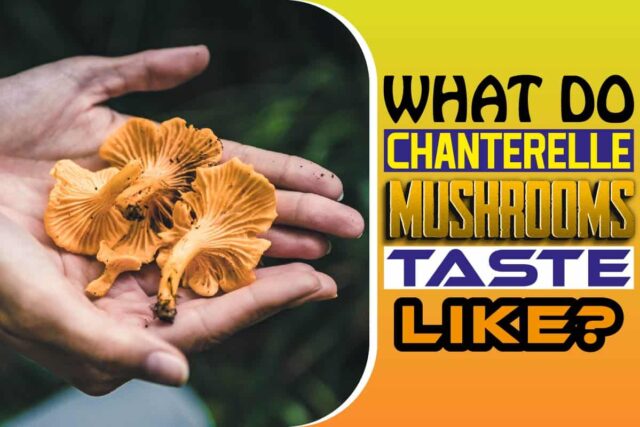Chanterelle Mushrooms are one of the most popular mushrooms in the world. They are best known for their yellow-orange color. They come in petite sizes. But, they are found to weigh up to two pounds.
These mushrooms are delightful in appearance. And at first glance, anybody would want to know how they taste.
It will also interest you to know that these beautiful golden Chanterelle mushrooms are an age-long delicacy globally.
So, what do chanterelle mushrooms taste like?
Chanterelle Mushrooms have a mild pepper taste. They taste almost like a combination of black pepper, earth note, apricot, and butter.
Most people claim the mushrooms boast a light fruity taste as well. Chanterelles, when cooked, are chewy. And it has a velvet consistency. And, they make an excellent combination for several dishes.
Chefs love this mushroom for its chewy texture and fruity scent. There are different species of chanterelle mushrooms all over the world. Some of which include cinnabar-red, smooth, small, white chanterelle.
Continue to learn more about this incredible mushroom.
Where Can I Find Chanterelle Mushrooms
Chanterelles are found near water sources in hardwood forests. Unlike other mushrooms, you can’t find them growing in fields, decaying woods, or thick clusters.
They tend to grow in areas like beech forests, shaded hills, or edges of waterways in the U.S. Chanterelle mushrooms are found throughout the United States. However, they do not grow in Hawaii.
Chanterelles tend to grow very slowly. They usually require lots of rain and heat during their development process. This is why they are very costly. A pound of dry chanterelle cost about $224.
Also, chanterelles grow from late spring or midsummer into early fall. However, this may differ based on the location. The mushroom is usually in season from July to September.
They are found across different countries like the U.S, Africa, Canada, Mexico, Asia, Europe, and West Coast.
How Do I Know Chanterelle Mushrooms When I See One
At first sight, chanterelles are usually recognized for their deep yellow-orange color. Also, their funnel-like shape helps them stand out.
However, there are other things you’d need to look out for when picking out chanterelles. The first is their grills. You’ll find their grills underneath their cap.
Chanterelles grills are forked and melted. Their grills look more like wrinkles. And it usually extends to the stem.
The next thing to look out for is the stem. Chanterelles stem comes in a lighter shade of yellow-orange color than the cap. Again, underneath the stem is usually white or a slightly creamy color.
Lastly, chanterelles have spores in them. The spores are usually creamy white or pale yellow colors.
Chanterelle mushrooms are often confused with Jack O’lantern and the false chanterelle. Jack O’lantern and the false chanterelle are poisonous mushrooms.
These mushrooms contain toxin muscarine. And so, you should not eat them. However, eating these mushrooms won’t kill you. But they can cause severe diarrhea, vomiting, and cramps.
Chanterelles And Jack O’lantern
Jack O’lantern shares some physical similarities with Chanterelles. They both have grills. And also, they have a combination of yellow and orange colors. And both have been identified to have a fruity-like smell.
However, these two mushrooms are very different. First, they differ in their colors. Jack O’lantern has a slightly darker yellow-orange color.
Also, Jack O’lantern has what is called true grills. Unlike Chanterelles mushrooms, their grills are sharp. Almost looking like a knife. Also, its grill appears to be easily broken from the cap. They are both shaped differently as well. Jack O’lantern has a rounded shape.
Chanterelles And False Chanterelle
False Chanterelles are also very similar to Chanterelles. They look a lot more identical to Chanterelles than Jack O’lantern. They share similarities in color, shape and the presence of grills makes them similar as well.
However, they are a lot smaller compared with Chanterelles mushrooms. And this can make one assume it’s a young chanterelles mushroom at first sight.
A significant difference between these two is their smell. False chanterelles smell more like your typical mushroom. False chanterelle is more of an orange color than yellow. Chanterelles mushrooms are more yellow than orange.
They are also shaped differently. However, they both have funnel-like shapes. But, False chanterelles have a shallow funnel shape.
Are Chanterelle Mushrooms Healthy
Chanterelles are not just pleasing to the eyes. They’re also perfect for your health. Let’s look at some health benefits of chanterelle.
Good Source of Protein:
Chanterelle is a good source of protein. It contains 1.5% of protein, Which is close to the daily required protein intake. Proteins are perfect for bodybuilding.
They are perfect for growing hair, bones, nails, and muscles. And it helps to repair body tissues.
Excellent Source of Chitin and Chitosan:
Chanterelle also contains a good amount of chitin and chitosan. These nutrients are perfect for your cells. They protect your cells from damage.
Also, they stimulate your immune system to produce more cells. They have also been found to reduce the risk of certain cancers.
Rich in Iron:
Iron does a lot to your body. It is an excellent immune booster. It also helps regulate your body temperature.
Irons are very beneficial to the brain as well. Studies show that it helps blood flow to the brain. Iron proteins help the process of brain development. The proper intake of iron can reduce the risk of degenerative diseases.
Rich in Vitamins:
Vitamins are essential to the body. Chanterelle mushroom is a good source of vitamins. It contains Vitamin D, Vitamin B3, Vitamin B5, and Riboflavin.
The presence of Vitamin D is good for developing healthy bones. It stimulates proteins in your small intestine.
It helps your body absorb calcium. It also strengthens your bones. Iron helps your body fight against bone conditions such as osteoporosis and osteomalacia.
Vitamin D also helps to reduce the risk of type 2 diabetes. It has been found to help with beta-cell function, inflammation, and insulin sensitivity. And these are good for diabetes treatment.
Chanterelle also contains vitamin B3. It is perfect for healthy skin. And it is best for reducing acne and other skin infections.
Lastly, the presence of vitamin B5 also plays a significant role in reducing stress and anxiety. It also helps in lowering blood pressure.
Are Chanterelles Poisonous
Chanterelles provide a lot of health benefits. But it could also pose a trait that may be dangerous to your health.
However, this is only possible if eaten raw. Aside, chanterelles aren’t poisonous if eaten correctly. When consumed without cooking, they can cause nausea and vomiting.
How To Store Chanterelles
Chanterelles are only available at particular times of the year. And so, it is best to preserve them. It makes them available whenever you may need them. So, how can you store chanterelles?
There are two common ways to store chanterelles. Check them out below.
Cooking and Freezing:
The first step is to cook your chanterelles. You can cook your chanterelle by steaming, butter sauté, or dry sauté them. This retains the delicious flavor of your chanterelle.
When your chanterelle is done, store them. You have to store them in airtight bags or containers. Then, keep them away in your freezer until you’re ready to use them. Chanterelles are at their best quality when they’re cooked and refrigerated.
Pickle:
pickling is another preservative method you can consider. Usually, chanterelles tend to take the flavor of their brine. So, choose your brine and seasonings carefully. When that is done, refrigerate them until you’re ready to use them.
How To Prepare Chanterelle Mushrooms
Interestingly, you can prepare chanterelles in several ways. You can prepare it by steaming, butter or dry sauté your mushroom.
But first, you need to clean your chanterelles. Then, divide them into smaller pieces and then steam them.
You can also sauté butter by frying it with butter after washing it. This is another way to prepare your chanterelle mushroom. However, be sure to fry it until it’s dry.
Lastly, you can dry sauté it by frying it in a pan after washing it. But, this frying should be done without oil. Do this until it loses its moisture.
You can add chanterelle to your stew, rice dishes, soups, and more. This mushroom is also great when added to pasta. You can serve it in butter or cream sauces.
Chanterelle mushrooms are naturally sponge-like. So, you have to be careful, so they don’t get too wet. Chanterelles are excellent with meats like pork, quail, veal, chicken, etc. Having chanterelle mushroom with seafood like scallops, radish, or oysters is also a great combination.
Final Note
Chanterelle Mushrooms have a mild pepper taste. Their taste is similar to a combination of black pepper, earth note, apricot, and butter. This mushrooms’ taste is often described to be light fruity too.
Chanterelles have a chewy texture, a velvet consistency, and a unique fruity scent. And this is the reason why chefs love it.
Chanterelles are found in countries like the U.S, Africa, Canada, Mexico, Asia, Europe, and West Coast. They also came in different species like a cinnabar-red, smooth, small, white chanterelle.














